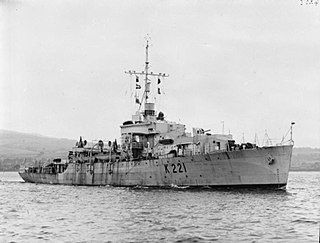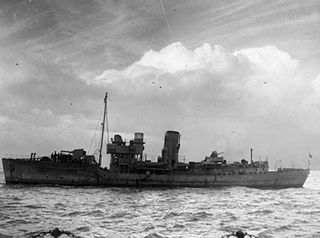
HMS Egret was a sloop of the British Royal Navy, the lead ship of her class. She was built by J. Samuel White at Cowes, Isle of Wight, was launched on 31 May 1938, and entered service on 11 November that year. Egret served as a convoy escort with the Western Approaches Command from 1940 until her loss in August 1943: She was on anti-submarine patrol in the Bay of Biscay when she was sunk by a guided missile in combat, the first ship to be lost in this manner.

The Flower-class corvette was a British class of 294 corvettes used during World War II, specifically with the Allied navies as anti-submarine convoy escorts during the Battle of the Atlantic. Royal Navy ships of this class were named after flowers, hence the name of the class.

HMS Duckworth (K351) was a Captain-class frigate of the Royal Navy. She served during the Second World War as a convoy escort and anti-submarine warfare vessel in the Battle of the Atlantic and was an effective U-boat killer, being credited with the destruction of five U-boats during the conflict.

HMS Nene was a River-class frigate, designed for anti-submarine operations, that served with the Royal Navy during the Second World War. In 1944 she was loaned to the Royal Canadian Navy and recommissioned as HMCS Nene, who returned her to the Royal Navy in 1945. Following the war she remained in reserve until disposed of in 1955.
HMS Gould (K476) was a British Captain-class frigate of the Royal Navy in commission during World War II. Originally constructed as the United States Navy Evarts-class destroyer escort USS Lovering (DE-272), she served in the Royal Navy from 1943 until her sinking in 1944.

HMS Alisma was a Flower-class corvette that served in the Royal Navy.

HMS Dart (K21) was a River-class frigate of the Royal Navy. Dart was built to the RN's specifications as a Group I River-class frigate.

HMS Dianella was a Flower-class corvette of the Royal Navy. She served during the Second World War.
HMS Itchen (K227) was a River-class frigate of the Royal Navy (RN). Itchen was built to the RN's specifications as a Group I River-class frigate. She served in the North Atlantic during World War II.

HMS Teviot (K222) was a River-class frigate of the Royal Navy (RN) from 1942–1955. She served in convoy defence duties in the North Atlantic and Eastern Fleet during World War II. After the war, she served in the South African Navy as HMSAS Teviot before returning to Royal Navy service after six months. Teviot was built to the RN's specifications as a Group I River-class frigate.

HMS Chelmer (K221) was a River-class frigate of the Royal Navy (RN) from 1943–1957. She served in convoy defence duties in the North Atlantic during World War II. Chelmer was built to the RN's specifications as a Group I River-class frigate, though Chelmer was one of the few powered by a turbine engine.

HMS Cam (K264) was a River-class frigate of the Royal Navy (RN) from 1944–1945. She served in convoy defence duties in the North Atlantic during World War II. Cam was built to the RN's specifications as a Group II River-class frigate, though Cam was one of the few powered by a turbine engine.
HMS Cuckmere (K299) was a River-class frigate of the Royal Navy (RN) in 1943. Cuckmere was originally to be built for the United States Navy, having been laid down as PG-104, but was transferred to the Royal Navy as part of Lend-Lease and finished to the RN's specifications as a Group II River-class frigate. She was first Royal Navy ship to carry the name Cuckmere.

HMS Mourne (K261) was a River-class frigate of the Royal Navy (RN). Mourne was built to the RN's specifications as a Group II River-class frigate. She served in the North Atlantic during World War II.
HMS Tweed (K250) was a River-class frigate of the Royal Navy (RN). Tweed was built to the RN's specifications as a Group I River-class frigate, though Tweed was one of the few powered by a turbine engine. She served in the North Atlantic during World War II.

HMS Hibiscus was a Flower-class corvette, built for the Royal Navy during the Second World War, and was in service in the Battle of the Atlantic. In 1942 she was transferred to the United States Navy as part of the Reverse Lend-Lease arrangement and renamed USS Spry, one of the Temptress-class gunboats. With the end of hostilities she was returned to the Royal Navy and sold into mercantile service.

HMS Periwinkle was a Flower-class corvette, built for the Royal Navy during the Second World War, and was in service in the Battle of the Atlantic. In 1942 she was transferred to the United States Navy as part of the Reverse Lend-Lease arrangement and renamed USS Restless, one of the Temptress-class gunboats. With the end of hostilities she was returned to the Royal Navy and sold into mercantile service.

HMS Larkspur was a Flower-class corvette, built for the Royal Navy during the Second World War, and was in service in the Battle of the Atlantic. In 1942 she was transferred to the United States Navy as part of the Reverse Lend-Lease arrangement and renamed USS Fury, one of the Temptress-class gunboats. With the end of hostilities she was returned to the Royal Navy and sold into mercantile service.

HMS Lark was a modified Black Swan-class sloop of the Royal Navy. She was laid down by Scotts Shipbuilding and Engineering Company, Greenock on 5 May 1942, launched on 28 August 1943 and commissioned on 10 April 1944, with the pennant number U11.















